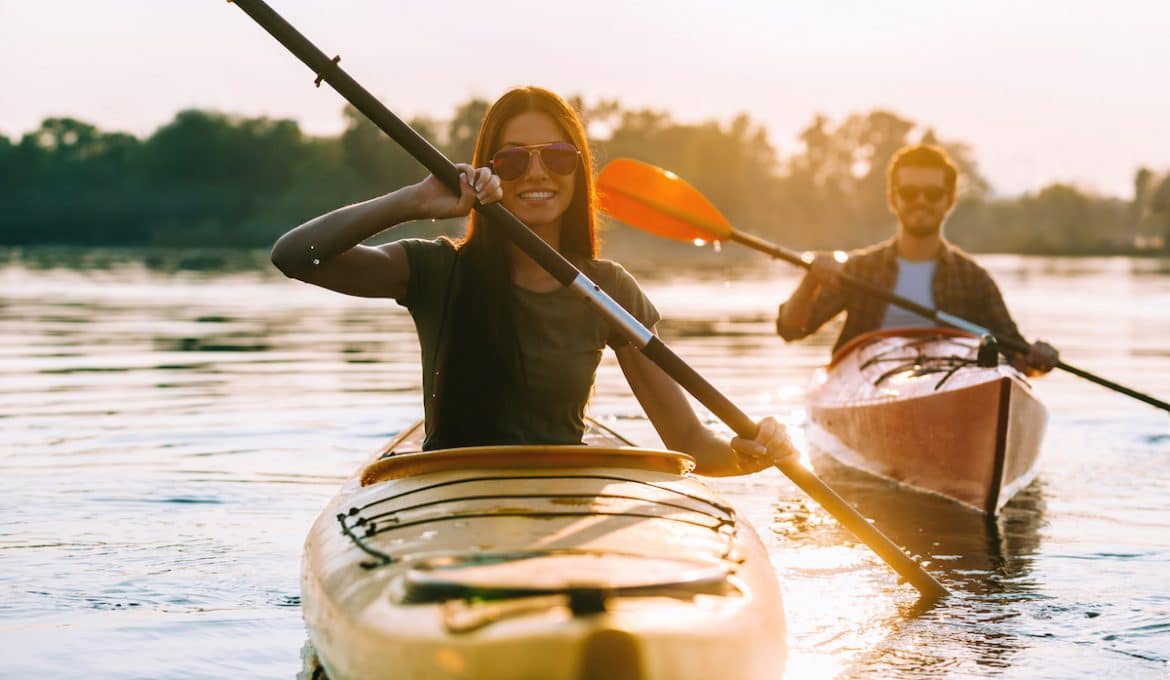The styles of kayaks on the market and options to customize are seemingly endless. If you’re just getting into kayaking or considering what kayak to purchase, it can feel very overwhelming. Use this guide to familiarize yourself with the main types of kayaks on the market.
Recreational Sit-on-top Kayaks

Sit-on-top kayaks like this Perception Pescador are common around sheltered bodies of water like lakes, ponds, and easy-flowing rivers. They are most often found in climates where the air and water temperatures are warmer.
Typically between nine and 12 feet long, recreational sit-on-tops are easy to get in and out of—especially if you are trying to get back in while in deep water. Scupper holes make them self-draining so you won’t need to worry about getting swamped.
Longer sit-on-top kayaks can have ample storage inside the hollow hull for short kayak-camping trips. However, they are typically heavier than other kayak options.
Recreational Sit-In kayaks

Sit-in kayaks are stable, lightweight and easy to use. Like recreational sit-on-top kayaks, sit-ins like the Perception Prodigy cater to the lake and easy-flowing river settings.
They offer more protection from cool water and air (especially when you add a spray-skirt). Also averaging nine to 12 feet long, sit-in kayaks are generally more efficient to paddle than sit-on-top kayaks because of a lower center of gravity and more points of contact between your body and the boat—bottom, knees, and feet are all points of contact with a sit-in kayak.
Because there are no scupper holes for drainage, you’ll need a bilge pump in case you get swamped and you will want to learn to do a “wet exit” in the event of capsizing.
Touring Kayak

Touring kayaks are usually a sit-in design with longer, narrower hulls (between 12 and 15 feet long). Touring kayaks like the Perception Carolina and the Perception Conduit offer more stability in rough conditions, travel faster, and track straight.
Their size and weight make them easier to transport than sea kayaks and you will have plenty of cargo space for multi-day adventures. Touring kayaks are a great balance of performance, comfort, and stability.
Sea Kayaks
These are long, sleek sit-in kayaks designed to go far with ease. Sea kayaks have a rudder or skeg to help deal with currents and wind conditions and a small cockpit (hole you sit in). The narrow cockpit is for a skirt to keep water out and thigh hooks that allow you to use your legs for more control.
They offer ample storage space for long kayak-camping trips. These perks come with a higher price tag and are arguably the least versatile kayak. They’re designed to track straight over long distances, not navigate winding rivers.
Fishing Kayaks

Fishing kayaks are usually sit-on-top and offer design features specifically for anglers, including either built-in rod holders or after-market attachments. They are stable and easy to maneuver in a variety of settings.
From a simple sit-on-top with an added rod holder to high-end fishing kayaks with pedal-propulsion systems, these kayaks come in a variety of styles and price points. Think of these as customized recreational kayaks with added benefits.
Whitewater Kayaks
If the adrenaline rush of whitewater rapids is your jam, then your only logical choice is a whitewater kayak. These are short, light, and agile kayaks designed for those “Class V” rapids or rocky rivers with short waterfalls. Whitewater is a whole different type of kayaking.
Non-traditional Kayak Options

If space and storage is a concern for you or if your adventures take you to remote lakes and rivers, perhaps a folding kayak is what you are looking for. Like a giant plastic origami, these kayaks are lightweight and store small.
Folding kayaks are not as durable as hard-shell kayaks but they handle well and have suitable storage capacity for gear. You won’t want to take a folding kayak out on sea kayaking trip though.
Inflatable kayaks are also space savers and surprisingly durable. Their wide base means they are very stable boats, ideal for floating down slow-moving rivers or exploring lakes. Some inflatable kayaks are rugged enough for flowing rivers with obstacles and a few are designed with kayak camping in mind.
The tandem kayak is the boat built for two. It’s perfect for bringing your kid-adventurer along or enjoying the waterways with your significant other. While you save money purchasing one boat instead of two, you sacrifice the option of a solo trip (it’s difficult to maneuver a tandem kayak alone).
Tandem kayaks are stable but long. Be sure to consider storage and transportation if you are considering a tandem kayak (but there are even inflatable tandem kayaks out there).
What kayak type sounds right for you? Do you have any further questions? Leave a comment below.





